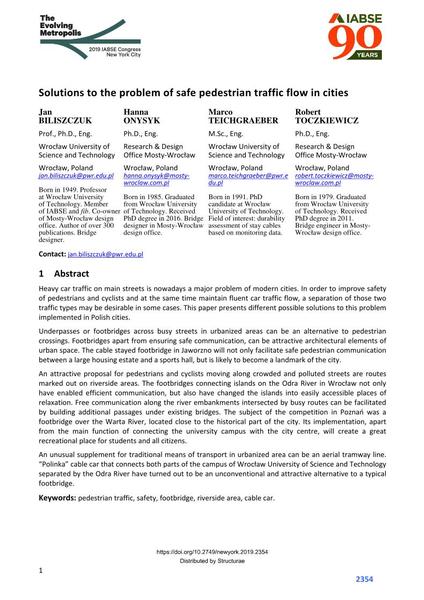Solutions to the problem of safe pedestrian traffic flow in cities

|
|
|||||||||||
Détails bibliographiques
| Auteur(s): |
Jan Biliszczuk
Hanna Onysyk (Research & Design Mosty-Wrocław) Marco Teichgraeber (Wrocław University of Science and Technology) Robert Toczkiewicz (Research & Design Mosty-Wrocław) |
||||
|---|---|---|---|---|---|
| Médium: | papier de conférence | ||||
| Langue(s): | anglais | ||||
| Conférence: | IABSE Congress: The Evolving Metropolis, New York, NY, USA, 4-6 September 2019 | ||||
| Publié dans: | The Evolving Metropolis | ||||
|
|||||
| Page(s): | 2354-2362 | ||||
| Nombre total de pages (du PDF): | 9 | ||||
| DOI: | 10.2749/newyork.2019.2354 | ||||
| Abstrait: |
Heavy car traffic on main streets is nowadays a major problem of modern cities. In order to improve safety of pedestrians and cyclists and at the same time maintain fluent car traffic flow, a separation of those two traffic types may be desirable in some cases. This paper presents different possible solutions to this problem implemented in Polish cities. Underpasses or footbridges across busy streets in urbanized areas can be an alternative to pedestrian crossings. Footbridges apart from ensuring safe communication, can be attractive architectural elements of urban space. The cable stayed footbridge in Jaworzno will not only facilitate safe pedestrian communication between a large housing estate and a sports hall, but is likely to become a landmark of the city. An attractive proposal for pedestrians and cyclists moving along crowded and polluted streets are routes marked out on riverside areas. The footbridges connecting islands on the Odra River in Wrocław not only have enabled efficient communication, but also have changed the islands into easily accessible places of relaxation. Free communication along the river embankments intersected by busy routes can be facilitated by building additional passages under existing bridges. The subject of the competition in Poznań was a footbridge over the Warta River, located close to the historical part of the city. Its implementation, apart from the main function of connecting the university campus with the city centre, will create a great recreational place for students and all citizens. An unusual supplement for traditional means of transport in urbanized area can be an aerial tramway line. “Polinka” cable car that connects both parts of the campus of Wrocław University of Science and Technology separated by the Odra River have turned out to be an unconventional and attractive alternative to a typical footbridge. |
||||
| Mots-clé: |
passerelle
|
||||
